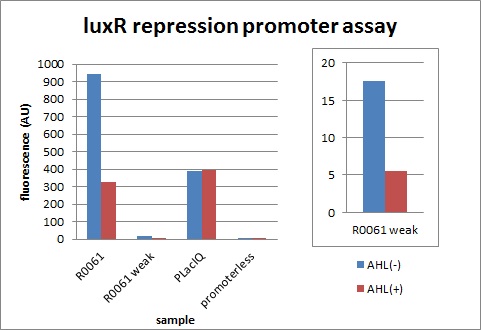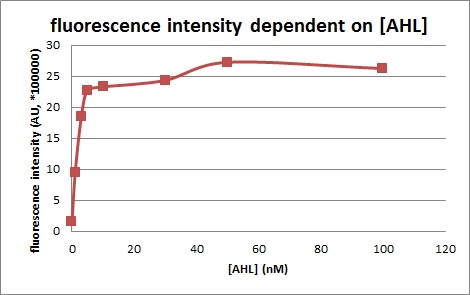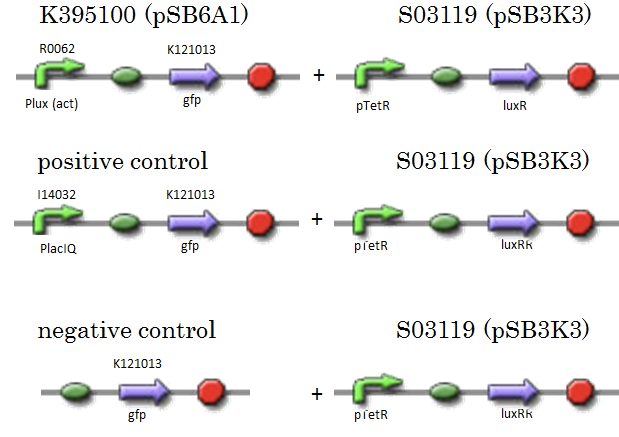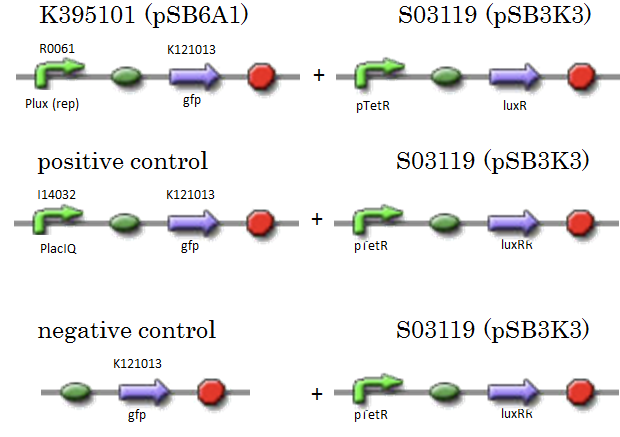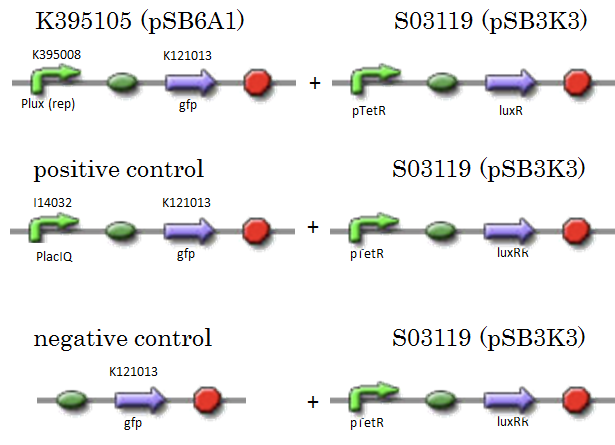Team:Tokyo Tech/Project/Artificial Cooperation System/lux act rep
From 2010.igem.org
(→Abstract) |
(→Abstract) |
||
| Line 43: | Line 43: | ||
| - | <br>[[IMAGE:Tokyotech_plux_act1_final.jpg| | + | <br>[[IMAGE:Tokyotech_plux_act1_final.jpg|345px|left]] |
| - | + | [[IMAGE:Tokyotech_plux_rep_both_final.jpg|300px]] | |
=Introduction= | =Introduction= | ||
Revision as of 14:58, 27 October 2010
Contents |
’lux’ activation/repression promoter
Abstract
In Artificial Cooperation System, two types of cells use cell-to-cell communication to recognize population of the counterpart and help the other when one is dying. The QS in this cell-cell communication is regulated by transcriptional activation/repression. Therefore, we characterized activation/repression promoters. We examined the existing luxR repression promoter which has never been characterized before in BioBrick registry and found that the growth of cells was inhibited when cells produce large amount of GFP even it is repressed by AHL. For this reason, we designed the promoter transcripts appropriately when signal is on/off.
Introduction
In Synthetic Biology, transcription activation is used frequently. Transcription repression by using AHL is also important, however, the device which has delay for transcription/translation through inverter is used a lot in this case. We decided to experience luxR repression promoter for the quick response of signal dependent repression.
Result
R0, characterization of R0062 (promoter activated by LuxR/3OC6HSL)
First of all, we characterized well known luxR activation promoter, R0062, in order to establish our Tokyo_Tech tram experimental system for Artificial Cooperation System.
The expression of GFP with 100nM 3OC6HSL around 30 holds increased comparing with the expression without 3OC6HSL.
We confirmed fluorescence intensity of luxR activation promoter is dependent on 3OC6HSL concentration. The threshold of fluorescence intensity of R0062, luxR activation promoter regulated by 3OC6HSL is around 5nM.
R1, characterization of R0061 & K395008 (promoter repressed by LuxR/3OC6HSL)
R1-1, R0061 (promoter repressed by LuxR/3OC6HSL)
Next, we characterized the existing part R0061, luxR repression promoter. We examined whether the amount of transcription is appropriate when signal is off and how much this promoter represses.
The expression of GFP with 100nM 3OC6HSL dropped to 1/3 comparing with the expression without 3OC6HSL.
R1-2, K395008 (promoter repressed by LuxR/3OC6HSL)
We confirmed R0061 and found increase of cells was inhibited due to a high level of expression although it is repressed by AHL. Therefore, we designed a new appropriate promoter by changing one base of R0061.
The expression of GFP with 100nM 3OC6HSL dropped to 1/3 comparing with the expression without 3OC6HSL. We found the level of expression is appropriate and this promoter work as expected.
Conclusion
We designed the new promoter which is repressed LuxR/3OC6HSL complex by changing one base of existing promoter. We confirmed this promoter works as we expected.
Material & Methods
M0, characterization of R0062 (promoter activated by LuxR/3OC6HSL)
fluorescence intensity in the presence/absence of AHL
We constructed K395100 combining R0062 and K121013. K121013 is a promoter-less gfp reporter (rbs-gfp-ter-ter) on pSB6A1. S03119 is a LuxR generator which is regulated by PTetR, which is repressed by TetR. In this experiment, we don’t use TetR, so S03119 functions as a LuxR constitutive generator. The backbone of S03119 is pSB1A2, which is a high copy plasmid, so we changed the backbone from pSB1A2 to pSB3K3. We used a fusion of PlacIq (I14032) to gfp (K121013) as a positive control and used promoterless gfp (K121013) as a negative control.
- samples
- [Plux act - GFP](BBa_K395100) on pSB6A1 + [PtetR – LuxR] on pSB3K3
- positive control: [PlacIq(constitutive promoter) - GFP] on pSB6A1+ [PtetR – LuxR] on pSB3K3
- negative control:. [promoterless - GFP] on pSB6A1+ [PtetR – LuxR] on pSB3K3
- Strain
DH5α
- protocol
- Prepare overnight culture.
- Take 30 ul of the overnight culture into LB + antibiotics (Amp + Kan). (→fresh culture)
- Incubate the fresh culture until the observed O.D. reaches around 0.60.
- Each sample was divided into 2. Prepare and add 3OC6HSL mixture to one, and add DMSO mixture to the other. The final concentration of 3OC6HSL is 100nM.
- Induction for 3 hours at 37°C.
- Fluorometer (FLA5200) and flow cytometry measurements for GFP expression.
fluorescence intensity dependent on [AHL]
- samples
- [Plux act - GFP](BBa_K395100) on pSB6A1 + [ptet – LuxR] on pSB3K3
- Strain
DH5α
- protocol
- Prepare overnight culture.
- Take 30 ul of the overnight culture into LB + antibiotics (Amp + Kan). (→fresh culture) Prepare the same 7 tubes for each sample.
- Incubate the fresh culture until the observed O.D. reaches around 0.60.
- Each sample was divided into 2. Prepare and add 3OC6HSL mixture. The final concentration of 3OC6HSL is 1, 3, 5, 10, 30, 50, 100nM.
- Induction for 3 hours at 37°C.
- Fluorometer (FLA5200) and flow cytometry measurements for GFP expression.
M1, characterization of R0061 & K395008 (promoter repressed by LuxR/3OC6HSL)
M1-1, characterization of R0061 (promoter repressed by LuxR/3OC6HSL)
We constructed K395101 combining R0061 and K121013, which is a promoter-less gfp reporter (rbs-gfp-ter-ter) on pSB6A1. S03119 is a LuxR generator which is repressed by TetR. In this experiment, we don’t use TetR, therefore, S03119 functions a LuxR constitutive generator. The backbone of S03119 is pSB1A2, which is a high copy plasmid, so we changed the backbone from pSB1A2 to pSB3K3. We used a fusion of PlacIq (I14032) to gfp (K121013) as a positive control and used promoterless gfp (K121013) as a negative control.
- samples
- [Plux rep - GFP](BBa_K395101) on pSB6A1 + [PtetR – LuxR] on pSB3K3
- positive control: [PlacIq(constitutive promoter) - GFP] on pSB6A1+ [PtetR – LuxR] on pSB3K3
- negative control: [promoterless - GFP] on pSB6A1+ [PtetR – LuxR] on pSB3K3
- Strain
DH5α
- protocol
- Prepare overnight culture.
- Take 30 ul of the overnight culture into LB + antibiotics (Amp + Kan).(→fresh culture)
- Incubate the fresh culture until the observed O.D. reaches around 0.80.
- Each sample was divided into 2. Prepare and add 3OC6HSL mixture to one, and add DMSO mixture to the other. The final concentration of AHL is 100nM.
- Induction for 2 hours at 37°C.
- Fluorometer (FLA5200) and flow cytometry measurements for GFP expression.
M1-2, characterization of K395008 (promoter repressed by LuxR/3OC6HSL)
We constructed K395105 combining K395008 and K121013. K121013 is a promoter-less gfp reporter (rbs-gfp-ter-ter) and this backbone is pSB6A1. Promoter of S03119 is PtetR, which is repressed by tetR. In this experiment, we don’t use TetR, so, S03119 functions a LuxR constitutive generator. The backbone of S03119 is pSB1A2, which is a high copy plasmid, so we changed the backbone from pSB1A2 to pSB3K3. We used a fusion of PlacIq (I14032) to gfp (K121013) as a positive control and used promoterless gfp (K121013) as a negative control.
- samples
- [R0061weak - GFP](BBa_K395105) on pSB6A1 + [PtetR – LuxR] on pSB3K3
- positive control: [PlacIq(constitutive promoter) - GFP] on pSB6A1+ [PtetR – LuxR]) on pSB3K3
- negative control: [promoterless - GFP] on pSB6A1+ [PtetR – LuxR] on pSB3K3
- Strain
DH5α
- protocol
- Prepare overnight culture.
- Take 30 ul of the overnight culture into LB + antibiotics (Amp + Kan). (→fresh culture)
- Incubate the fresh culture until the observed O.D. reaches around 0.60.
- Each sample was divided into 2. Prepare and add 3OC6HSL mixture to one, and add DMSO mixture to the other. The final concentration of 3OC6HSL is 100nM.
- Induction for 3 hours at 37°C.
- Fluorometer (FLA5200) and flow cytometry measurements for GFP expression.
</div>
</div>
 "
"

